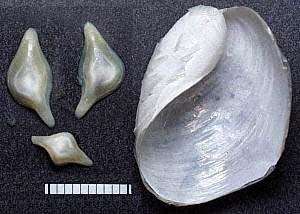
Philine orientalis?
A. Adams, 1854
Order: CEPHALASPIDEA
Family: Philinidae
DISTRIBUTION
This species was originally described from "Eastern Seas" and later by Watson (1886) from the Philippines. Subsequently it has been reported by various authors from Japan, and recently from Hong Kong.
PHOTO
Shell and gizzard plates from Tolo Channel, Hong Kong, 10m, April 1989. (Voucher specimen from Morton & Chiu, 1990). PHOTOS: Bill Rudman.
RELATED TOPIC
Philine orientalis? from California
It is difficult to be sure from the short unillustrated original description just what Philine orientalis is. This animal from Hong Kong is possibly Philine orientalis A.Adams but until more information is available on the anatomy and shell variation of species of Philine from the north-western Pacific region, a firm identification is impossible.
Reference:
• Adams, A. (1854) Descriptions of some new species of Lophocercidae and Philinidae, from the Cumingian Collection. Proceedings of the Zoological Society, 22: 94-95.
Rudman, W.B., 1998 (August 5) Philine orientalis? A. Adams, 1854. [In] Sea Slug Forum. Australian Museum, Sydney. Available from http://www.seaslugforum.net/find/philhk
Related messages
Re: Philine orientalis? from Singapore
March 17, 2009
From: Loh Kok Sheng
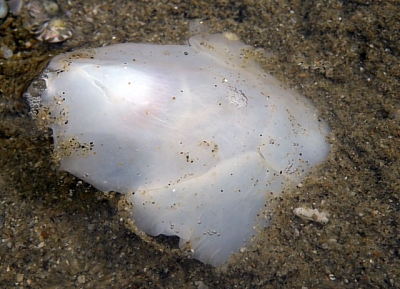

Concerning message #15459:
Dear Dr Bill,
Here are photos of Philine from Singapore. Thought it will be a first record for Singapore. Am not sure if you can get the identification from the photos.
Locality: Tanah Merah , Singapore, Singapore Straits, 7 February 2009, Intertidal, Sand bar. Length: 60 mm. Photographer: Loh Kok Sheng.
Thanks!
Loh Kok Sheng
kokshengz@gmail.com
Loh, K.S., 2009 (Mar 17) Re: Philine orientalis? from Singapore. [Message in] Sea Slug Forum. Australian Museum, Sydney. Available from http://www.seaslugforum.net/find/22341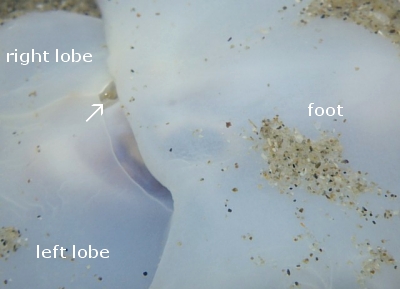
Dear Kok Sheng,
It is hard to be sure of its identification without looking at least at its internal shell and gizzard plates, but as I said in Dong Bum Koh's message, this muscular, wedge-shaped body form is only found in a few species, including P. orientalis.
For those unfamiliar with species of Philine, your upper photo shows an animal burrowing into the sandy bottom. The wedge-shaped and muscular body are modified for this burrowing life. The front end of the body, including most of the head shield and flanking parapodia are almost totally buried, while the 'posterior shield' with the bright white internal shell are still visible.
The middle photo shows the ventral side of an animal which has been lying on its back and has just buried its head [right end of photo] in the sand and I assume is about to flip over before completely burying itself. The lower photo is a close-up of part of the ventral photo and I have labelled a few of the body parts. As in many cephalaspideans, the foot does not extend to the posterior end of the body, usually the most posterior part of the body is the shell. In species, such as Philine, in which the shell is internal we call the part of the body that encloses the shell and the remnant mantle cavity the posterior shield. In the lower photo we can see how the posterior shield folds under to form to lobes which enclose the mantle cavity and gill. I have arrowed the opening through which water is drawn inot the mantle cavity.
Best wishes,
Bill Rudman
Shell & gizzard plates of Philine orientalis
May 2, 2006
From: Dong Bum Koh
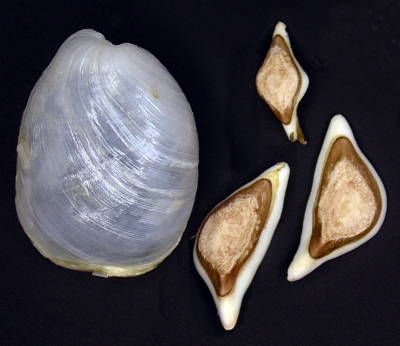
Dear Bill,
Concerning earlier message [#15459 ]:
Hear are the shell & gizzard plates extracted from an animal of the same species. Lengths: Shell 21 mm; large gizzard plates 18 mm; small plate 11 mm.
Also another photo of the animal. Locality: Hwa Soon. Jeju island, South Korea. Pacific. Depth: 5 m. 22 April 2006. Sandy bottom. Photographer: Dong Bum Koh.
Best regards,
Dong Bum Koh
drkoh@seasee.co.kr

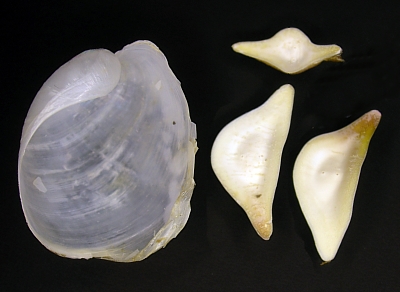
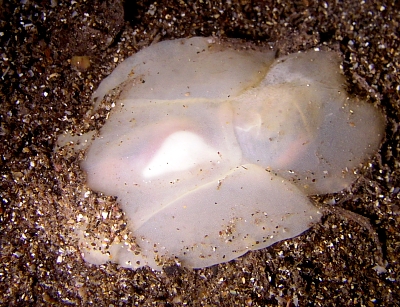
Dear Koh,
I am glad to see my prediction about the shape of the gizzard plates proved correct. There seems to be an evolutionary sequence in the genus from 'primitive' species with small uncalcified plates all of similar shape and size, through species with small equi-sized calcareous plates [see Philine auriformis], to the large muscular species like this one with large calcareous plates, two of which are large and mirror images of each other, and a third smaller one of a more symmetrical shape. I have also included a close-up of the inside of one of the large gizzard plates to show the pair of microscopic holes they usually have. I have no idea of their function - if any.
As you can see in the photo alongside, the gizzard plates can often be seem through the body wall of the living animals.
Best wishes,
Bill Rudman
Philine orientalis from South Korea
December 16, 2005
From: Dong Bum Koh
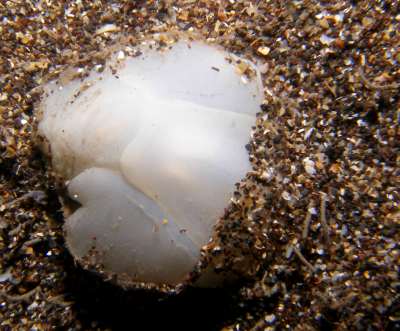
Dear Bill,
Here is a photo what I think of Philine orientalis from South Korea. This animal digs into the sandy bottom and therefore we can't see the head region.
Locality: Hwa Soon. Jeju island, South Korea. Pacific. Depth: 5 m. Length: approx. 60 mm. 21 Oct. 2005. Sandy bottom. Photographer: Dong Jin Kim
Best regards,
Dong Bum Koh
drkoh@seasee.co.kr
Koh, D.B., 2005 (Dec 16) Philine orientalis from South Korea. [Message in] Sea Slug Forum. Australian Museum, Sydney. Available from http://www.seaslugforum.net/find/15459Dear Koh,
As I discuss on the Fact Sheet and earlier messages, there is some doubt concerning the identity of Philine orientalis because it wasn't well described. However if we accept it is the species identified from Hong Kong as P. orientalis [see message #192], then the body shape of your animal is the same. Philine angasi from Australia and New Zealand, and P. aperta from the Atlantic are two of a small group of large species of Philine which are instantly recognisable from the shape and nature of their gizzard plates, which are heavily calcified and consist of 2 large plates, which are mirror images of each other, and a third, much smaller plate of a much more symmetrical shape. These species have a much more muscular body than other species of Philine, and the parapodia are large flattened muscular structures which give the body a flattened, stiff, wedge-like shape, making them very efficient burrowers. Your animal has this shape, whcih fits with the gizzrd plate morphology of what we are calling P. orientalis from Hong Kong.
Best wishes,
Bill Rudman
Radula of Hong Kong Philine orientalis
August 10, 1998
From: Bill Rudman

Here are some radular photos to compare with the species from California. The major difference in the radular teeth is the presence of the fan-like compound denticles in these animals from Hong Kong. They were also reported by Morton & Chiu, but as my material was from their samples, I don't know whether these compound denticles are characteristic of the species or whether pollution or some other factor has produced aberrant teeth in this population.
UPPER: Whole radula.
MIDDLE: some teeth from the left side, showing denticles along the edge of each tooth. Note compound denticles in the midsection.
LOWER: magnified view of compound denticles.
PHOTOS: Alison Miller.
Rudman, W.B., 1998 (Aug 10). Comment on Radula of Hong Kong Philine orientalis by Bill Rudman. [Message in] Sea Slug Forum. Australian Museum, Sydney. Available from http://www.seaslugforum.net/find/203Philine orientalis? from Hong Kong
August 5, 1998
From: Bill Rudman

Here is some information on the Philine from Hong Kong which was studied by Morton & Chiu (1990). Its internal anatomy is very similar to that of the specimens of Species 1 I have looked at from California.
However, the shell is cut away at the bottom, not rounded as in Californian specimens and the gizzard plates slightly flatter. The pair of "pinholes" on the outside of the gizzard plates are not as prominent as in Californian specimens. The radular teeth are similar but as in Morton & Chiu's description the denticles often coalesce into clusters. In brief I am not sure whether this species is the same as the Californian species or if either are actually true Philine orientalis. ... Bill Rudman.
UPPER PHOTO: The inside of the gizzard plates. Scale = 10mm.
LOWER PHOTO: Outside of gizzard plates. Traces of the "pinholes" can be seen in the two larger plates. Inset showing dorsal view of shell.
PHOTOS: Bill Rudman
Morton, B. & Chiu, S.T., 1990. The diet, prey size and consumption of Philine orientalis (Opisthobranchia: Philinidae) in Hong Kong. Journal of Molluscan Studies, 56: 289-299.
Rudman, W.B., 1998 (Aug 5). Comment on Philine orientalis? from Hong Kong by Bill Rudman. [Message in] Sea Slug Forum. Australian Museum, Sydney. Available from http://www.seaslugforum.net/find/192